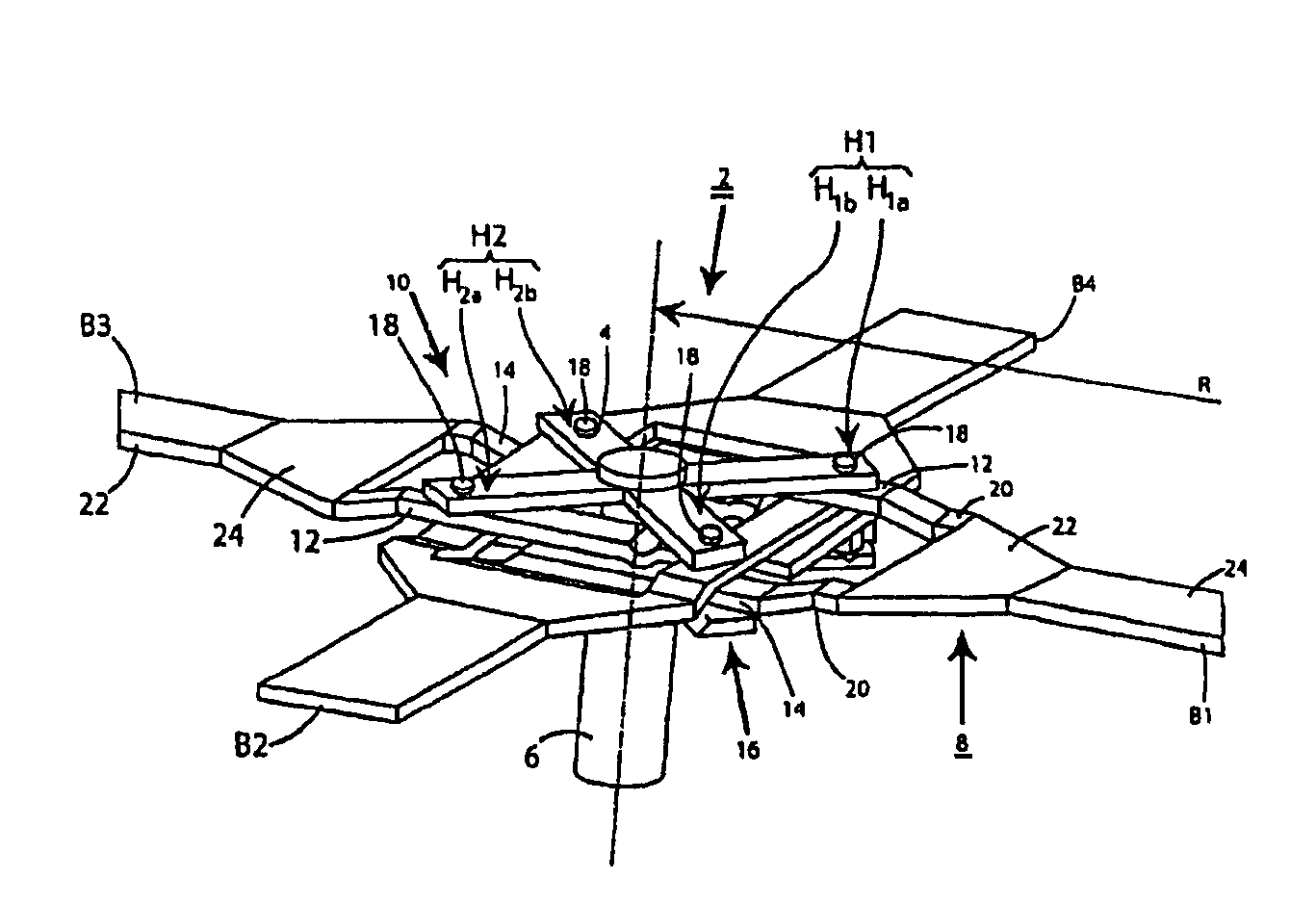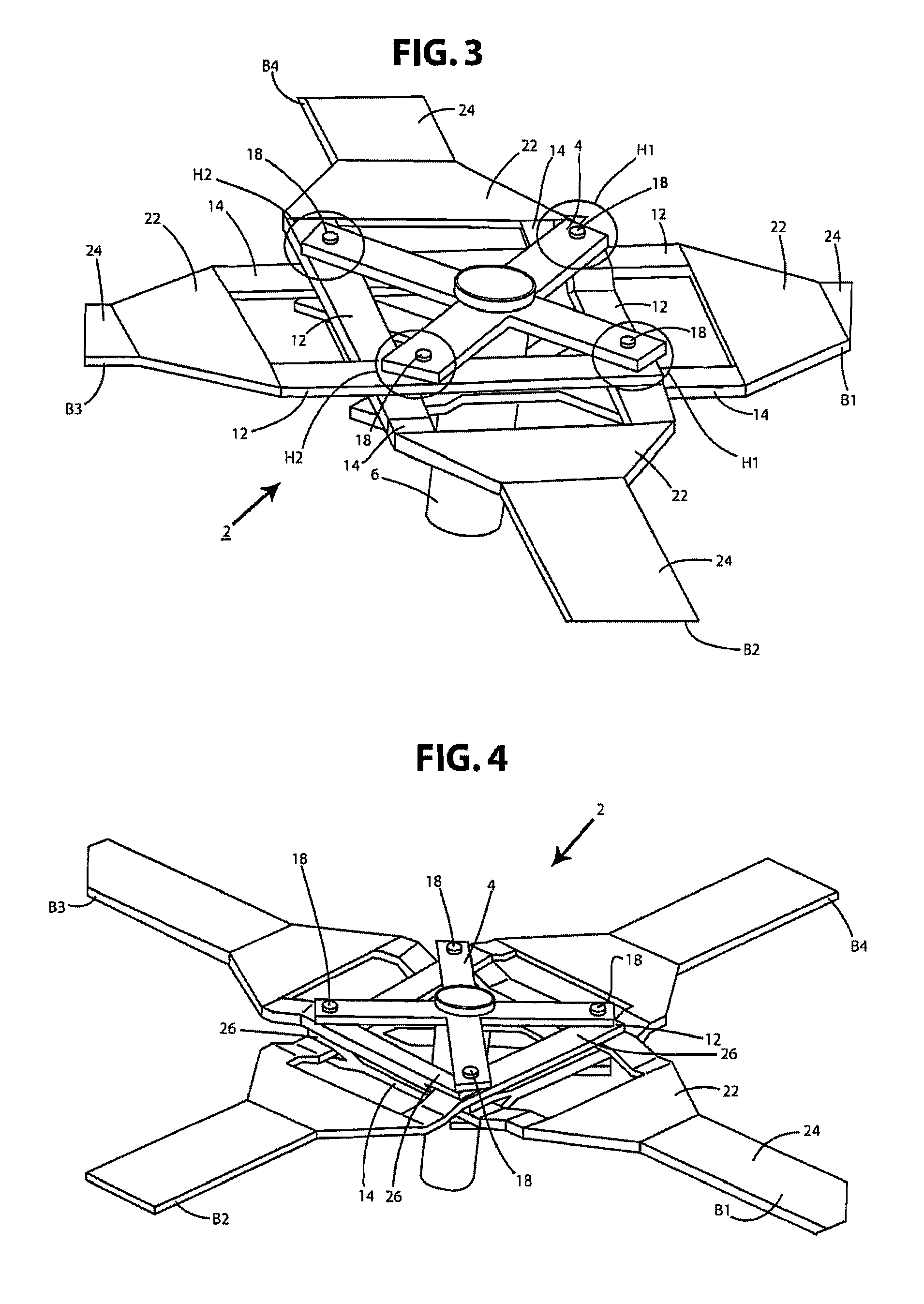Rotor and gyrocopter with said rotor
a rotor and gyrocopter technology, applied in the direction of liquid fuel engines, marine propulsion, vessel construction, etc., can solve the problems of large stress on the blade connector, the blade neck, and the difficulty of reducing the flapping hinge distance or reducing it below a specific value, so as to improve the flying comfort, the effect of improving the flying properties and ensuring the safety and reliability
- Summary
- Abstract
- Description
- Claims
- Application Information
AI Technical Summary
Benefits of technology
Problems solved by technology
Method used
Image
Examples
first embodiment
[0038]FIG. 1 is a schematic perspective plan view of a hingeless rotor according to the present invention in accordance with a The rotor encompasses a rotor head 2 having a plate-shaped, four-armed rotor star 4, flexurally soft in the flapwise direction, that engages nonrotatably on a rotor mast 6 and serves as a torque-transmission element, as well as four similarly configured rotor blades B1, B2, B3, B4. For the sake of clarity, the lift-generating regions of the rotor blades are not depicted in the drawing. The rotor blades are fabricated substantially from fiber composite material. Each two rotor blades B1, B3; B2, B4 that constitute a rotor blade pair are located at a 180-degree offset from one another. The two rotor blade pairs thus formed are in turn disposed at a 90-degree offset from one another. Each rotor blade possesses, for example, a blade neck 8 having flexurally soft, flexurally elastic blade-neck portions. Rotor blades B1, B2, B3, B4 are connected, in the region of...
second embodiment
[0056]In principle, however, the two connector arms 12, 14 of a respective rotor blade B1, B2, B3, B4 can also lie in a common plane, or in a common plane with the base portion and the strip-shaped blade-neck region. An embodiment of this kind is shown in FIG. 3, which is a schematic, perspective plan view of a rotor according to the present invention in accordance with a Here, for each rotor blade B1, B2, B3, B4, the free end of one connector arm 12, 14 is bent or stepped upward, and that of the other one downward.
third embodiment
[0057]FIG. 4 is a schematic, perspective plan view of a rotor according to the present invention in accordance with a This variant is largely similar to that of FIG. 1, but the free ends of connector arms 12, 14 of a rotor blade B1, B2, B3, B4 are each embodied in the form of a fork terminal 26. With the rotor in the assembled state, fork terminal 26 is located in the region of an auxiliary flapping hinge H1, H2 and is joined to a strip-shaped region, located in the vicinity of base portion 22, of a connector arm 12, 14 of a respectively adjacent rotor blade. Fork terminals 26 make it possible to achieve greater retention strength in the joining points located at auxiliary flapping hinges H1, H2, and easier positionability during the assembly of rotor blades B1, B2, B3, B4.
PUM
 Login to View More
Login to View More Abstract
Description
Claims
Application Information
 Login to View More
Login to View More - R&D
- Intellectual Property
- Life Sciences
- Materials
- Tech Scout
- Unparalleled Data Quality
- Higher Quality Content
- 60% Fewer Hallucinations
Browse by: Latest US Patents, China's latest patents, Technical Efficacy Thesaurus, Application Domain, Technology Topic, Popular Technical Reports.
© 2025 PatSnap. All rights reserved.Legal|Privacy policy|Modern Slavery Act Transparency Statement|Sitemap|About US| Contact US: help@patsnap.com



